How the Andrews Forest and Moorea Coral Reef LTER sites respond to disturbance highlights the struggle and opportunity that come with an irreparably altered ecosystem.
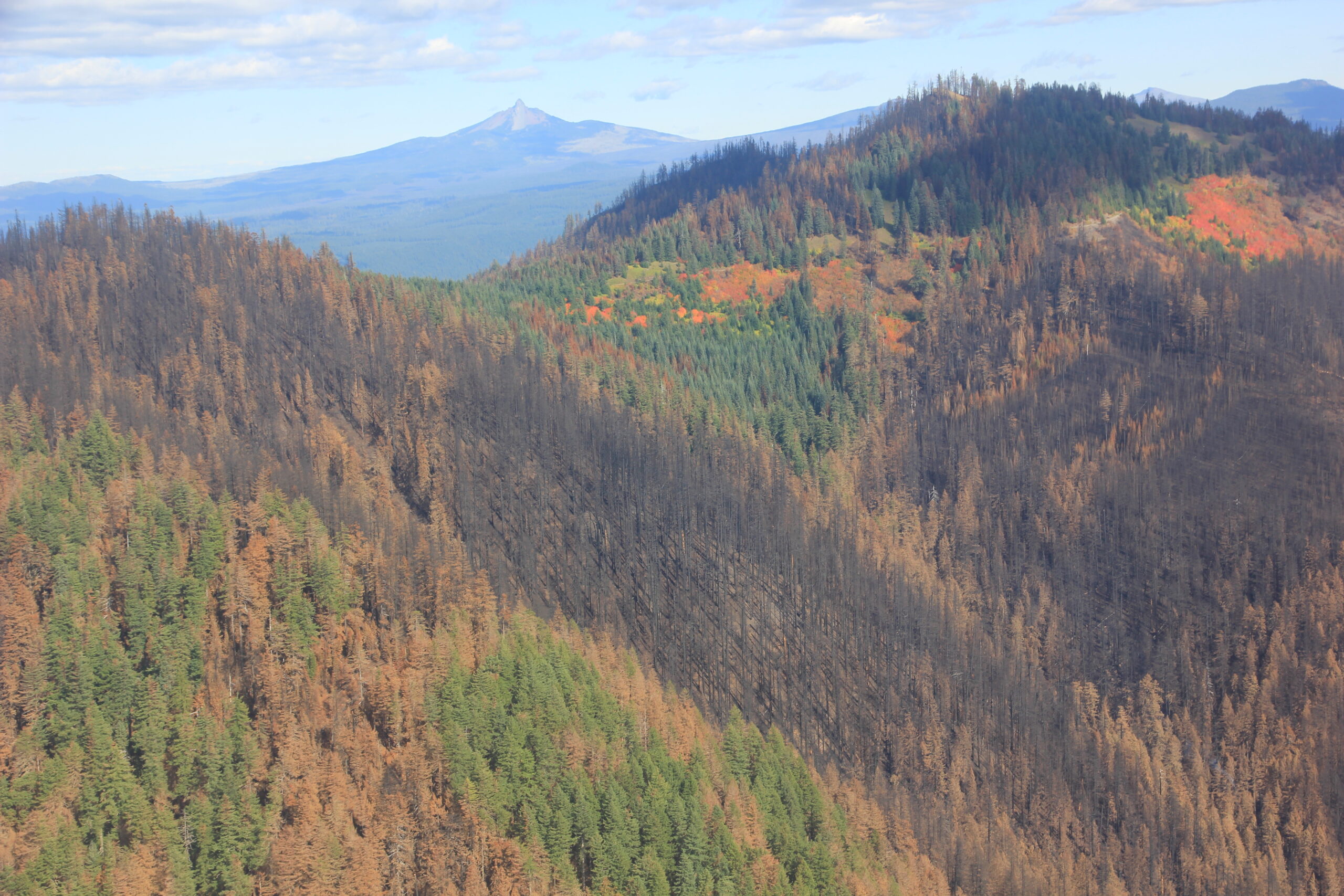
Credit: Mark Schulze, CC BY-SA 4.0.
A fire tears through a 500-year old forest. A pristine coral reef razed by a voracious sea star. Such catastrophic disturbance events are hard to watch. This is especially true at LTER sites, where decades of research can be upended overnight. Yet understanding disturbance is crucial to understanding how ecological systems work both now and well into the future.
At LTER sites, science is deeply place-based, highly adaptive in scope and focus, and consistent over time. This combination of traits—rare outside of the LTER Network—allows sites to understand disturbance more comprehensively than many other approaches in ecology. Tracking two simultaneous disturbances in two very different ecosystems—the Lookout Fire at the Andrews Forest LTER and a Crown of Thorns Seastar outbreak at the Moorea Coral Reef LTER—highlights these advantages.
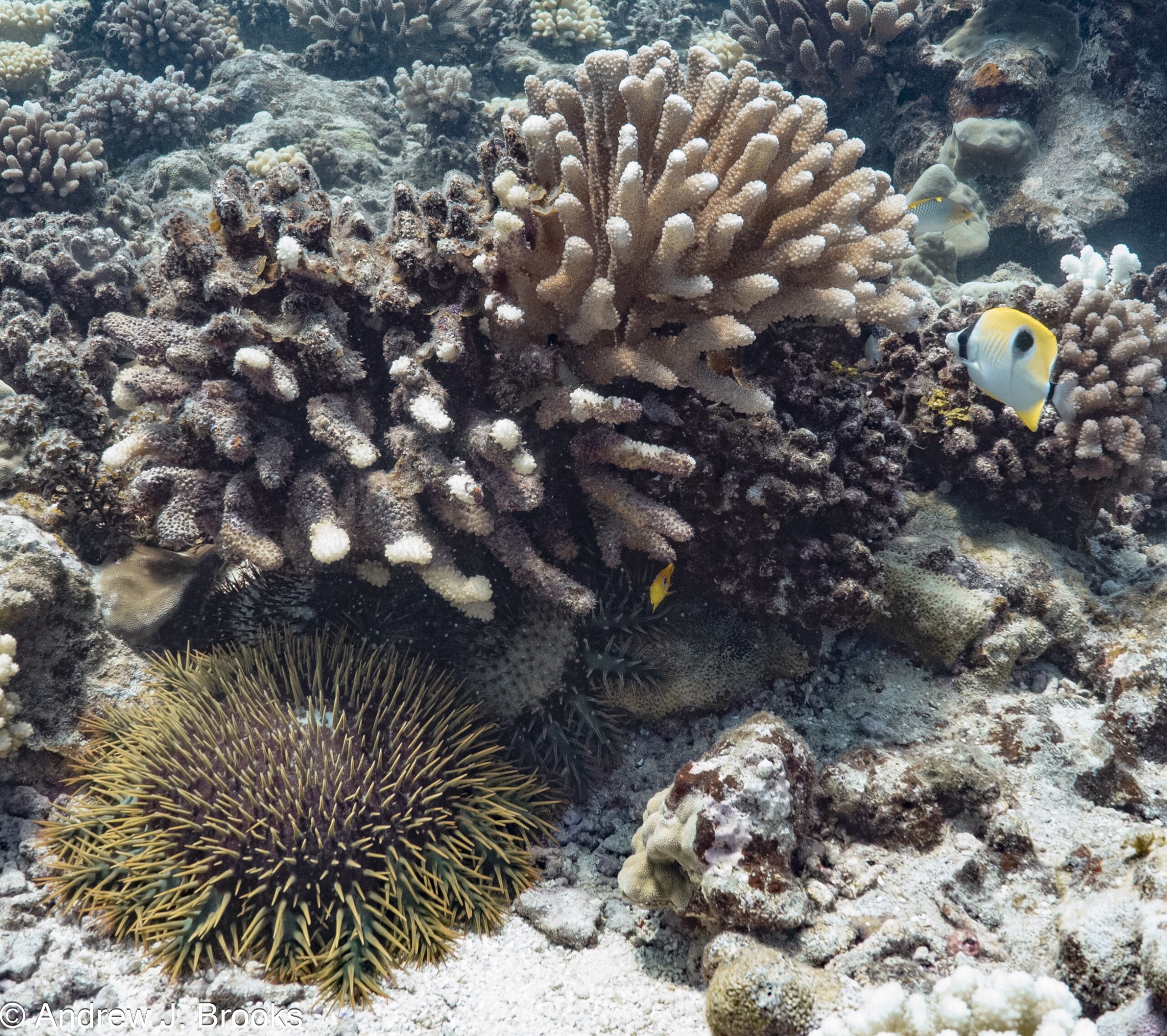
Credit: Andrew J. Brooks, used with permission.
Disturbance, a new frontier
The LTER’s first advantage is that sites are just there for a long time. LTER research at the Andrews Forest began in 1980. Some datasets are even older. “To our knowledge, there isn’t a dataset with as much pre-fire data as at Andrews,” said Matt Betts, Lead PI for the Andrews Forest LTER. He’s speaking broadly—it is unlikely that any dataset in the world has forty years of comprehensive ecological data before a blaze.
That long record of pre-fire data is a big advantage for understanding how the fire affected the Andrews Forest. Previously, the most common approach in fire ecology research was to find plots of trees two, ten, fifteen, or more years out of a fire and compare them. It’s a powerful approach, but prioritizes convenience (you can measure all the plots in a short time frame) over accuracy (it’s not the same plot).
Now, data at the Andrews can track the ecosystem from decades before the burn through the decades of recovery. It’s the same plot, too—there aren’t different plots substituted in at each time step. “It’s a very high level of rigor in fire ecology research” says Betts.
For Betts and others at the site, though, the future of research is still uncertain. Just months after the fire, the site is currently working hard to take stock of what was lost in the fire, secure funding for rebuilding their lost equipment and increased need for labor, and to prioritize a research agenda that takes full advantage of the opportunity after the burn.
That research agenda is starting to take shape. “A lot of really cool ideas are coming up in our brainstorming sessions,” says Betts, noting that more folks are coming to these meetings than before the fire. “I mean there’s just no fire experiment like this, right?,” says Mark Schulze, Andrews Forest Director . “Andrews researchers have been working on carbon models [in the forest] for four decades,” Schulze adds when asked for an example of future research. “We have all this pre-fire data on carbon stocks— and now we’ll be able to test some of the predictions of these models in terms of post-fire carbon dynamics.”
Disturbance, an old friend
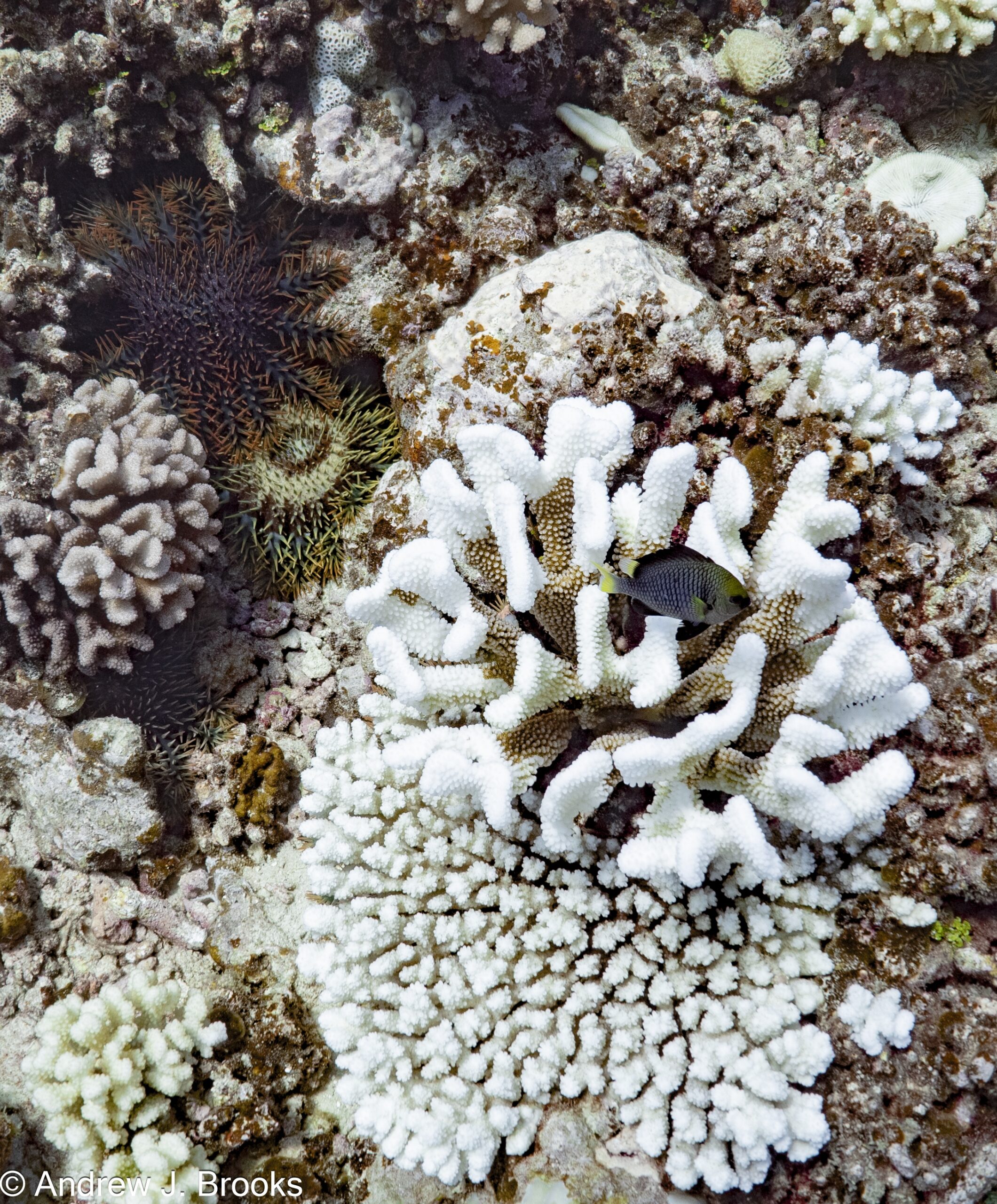
Credit: Andrew J. Brooks, used with permission.
Climate change, human impacts, natural disasters—it’s not a question of if a disturbance will hit a site, it’s a question of when. Yet sites can’t exactly plan for events that haven’t transpired. Andrews researchers couldn’t possibly know which parts of the forest would burn, and which would not.
LTER sites are designed to ask the most relevant ecological questions in their ecosystem. With that freedom comes an understanding that those questions will change over time—especially after ecosystem altering events like a fire or a bleached reef.
In Moorea, the 2023 Crown of Thorns Seastar outbreak is just another event in a long line of disturbances since the site’s founding in 2007. Their success at adapting research after each event is a testament to the value of this adaptive approach.
In 2007, just three years after becoming an LTER site, a mass outbreak of Crown of Thorns Seastars (COTS), a voracious coral predator, resulted in the consumption of much of the live corals on the reefs in Moorea. “We’re supposed to be NSF’s coral reef LTER site, right?” said Andrew Brooks, one of the Investigators with the Moorea Coral Reef LTER. “And we had almost no coral.”
After that first outbreak, MCR researchers faced the same uncertain future that the Andrews Forest scientists currently face: how to reschedule an entire research program around a new, dramatically altered ecosystem. “It actually turned out to be a good thing because it springboarded us into research about disturbance and multiple stable states,” says Andrew.
Currently, the coral reefs in Moorea are recovering from yet another island-wide disturbance, this time a mass coral bleaching event that again killed much of the living corals on Moorea’s reefs. Bleached reefs can remain in this disturbed state indefinitely or transition to one of two alternate states: back to a coral dominated ecosystem, or to an algae dominated system. At the time of that first COTS outbreak, coral reef ecologists didn’t know which factors determined whether a bleached reef would recover to a coral or algal dominated state.
After the 2007 Crown of Thorns outbreak, Moorea scientists began to parse the different physical and biological factors on a highly disturbed reef that lead to either coral or algal dominance. Through a series of observations and experiments, they started to make progress.
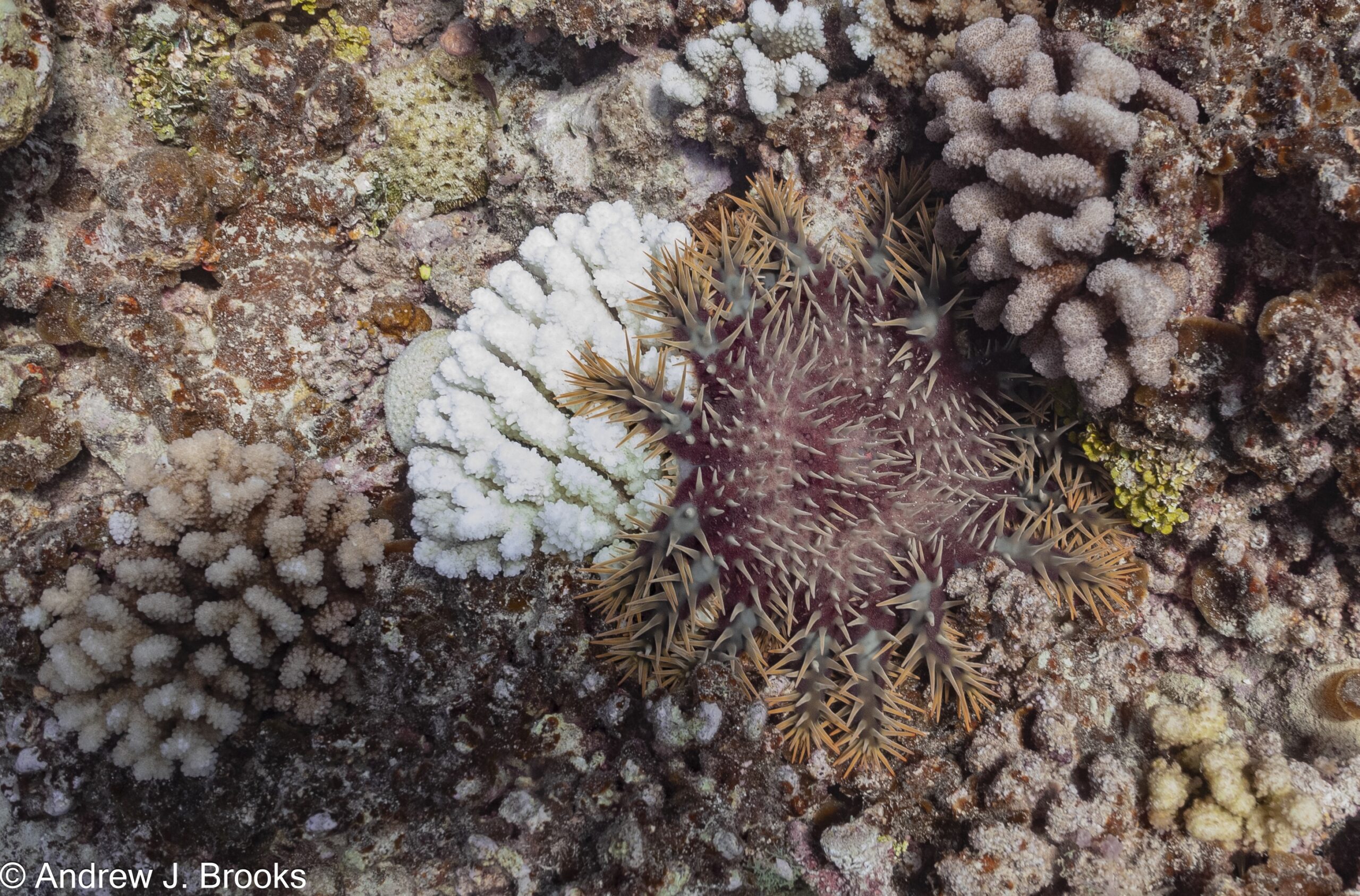
Credit: Andrew J. Brooks, used with permission.
But the real key to their research was a series of subsequent disturbances at the site: a large wave event associated with Cyclone Oli in 2010, an El Niño driven bleaching event in 2015, and marine heatwaves in 2017, 2019, and 2020, with the extreme thermal event of 2019 again resulting in a reef-scape composed primarily of dead coral colonies.
Coral reef recovery, MCR scientists found, depends strongly on the physical structure of the reef after a bleaching event. Cyclone Oli flattened the reef with huge waves, and removed the dead coral skeletons left behind by the 2017 COTS outbreak. Reef herbivores, primarily parrotfishes and surgeonfishes, proliferated in response and were able to keep the reef mostly free of macroalgae. Following a large coral recruitment event in 2013, the reef recovered to a coral dominated state. The marine heatwaves and subsequent COTS outbreak in 2023, however, left the three-dimensional structure of dead coral intact, and algae, now shielded from the herbivorous fishes, took over.
By pairing these observations with carefully designed experiments, MCR researchers are discovering that the physical structure of dead coral, a material legacy, shelters macroalgae from herbivorous fishes. If the reef bleaches, but the coral skeletons are left intact, macroalgae proliferates in these pockets of safety and may flip the reef into a macroalgae state. Remove that structure, though, and reef herbivores are able to keep the macroalgae at bay, allowing time for corals to eventually re-establish and dominate the landscape again.
Disturbance, a mixed bag
These days, Brooks, who’s been Investigator with the Moorea Coral Reef LTER site since its founding, sees disturbance as an opportunity. In the midst of yet another Crown of Thorns Seastar outbreak at the site, he remains upbeat. “We have a chance to actually answer some questions that people have been asking for quite a few years,” he says, referring to COTS outbreaks and reef recovery. “For me, [figuring out which questions to ask] is the really exciting phase of science. What kind of experiments do we do? What kind of observations do we need? How are we going to do these manipulations? What kind of apparatus do we need to build?”
Brooks’s perspective is a result of scientists with the MCR LTER site’s prior success in adapting their research after disturbance. Matt Betts’s attitude at the Andrews Forest is a bit more tentative. After all, the Lookout Fire is unprecedented—over two thirds of the Andrews Experimental Forest burned.
Research at the Andrews Forest relied on a wide network of sensors and experimental plots strewn across the forest. Much of that infrastructure was lost in the fire. To rebuild that network will cost a lot of time and money. “There has been a massive effort just trying to think about how we get back to where we were,” says Matt.
Graduate students are particularly hard hit by these disruptions. While long-term research objectives and tenured faculty have the privilege of patience, graduate students don’t. Many rely on projects expected to wrap up in just a few years. Without infrastructure, those projects are delayed indefinitely. “For graduate students,” says Betts, “this is an existential threat to their career training.”
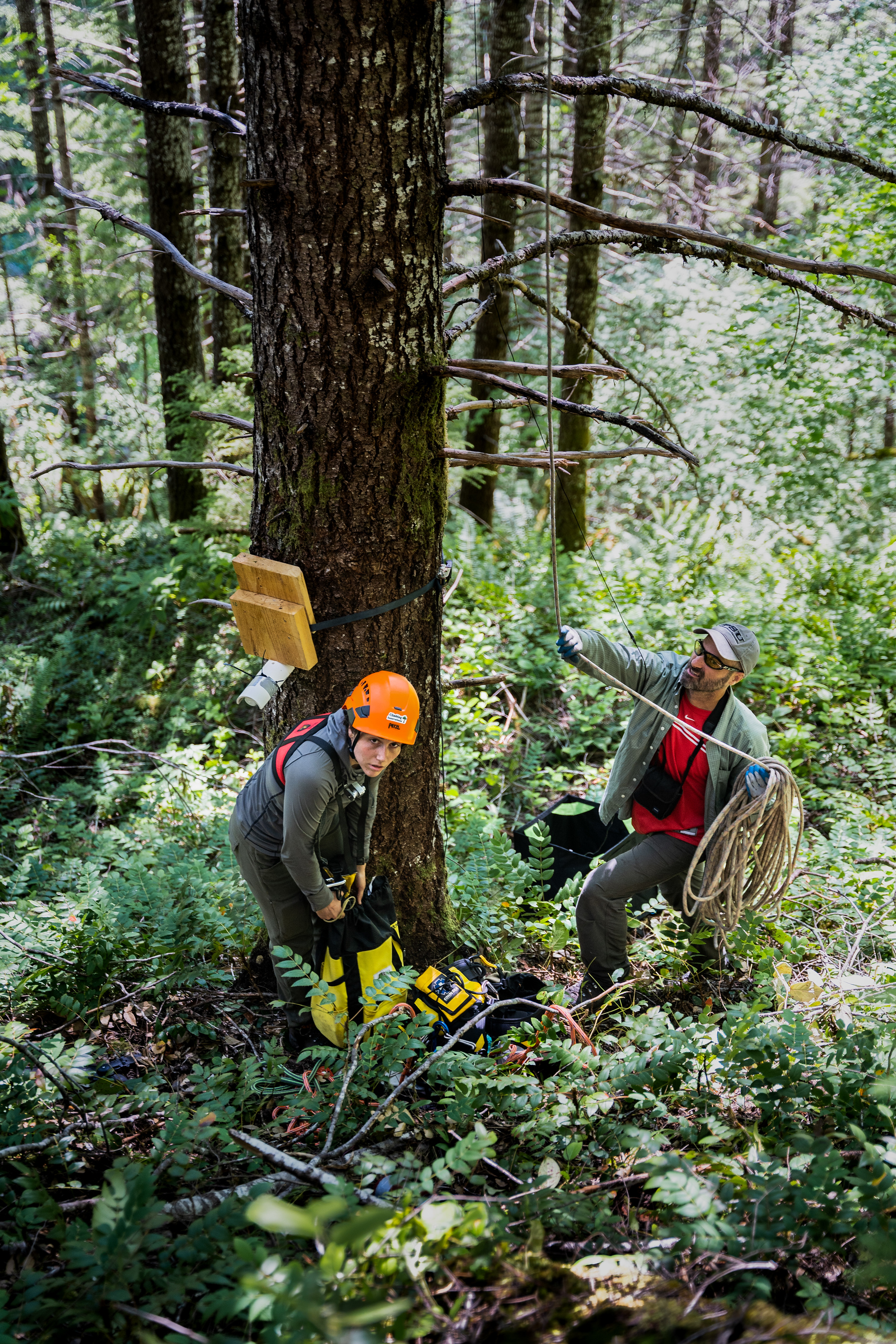
Credit: Gabriel De La Rosa, CC BY-SA 4.0
Nina Ferrari, a third year graduate student at the Andrews Forest, is grappling with the aftermath of the Lookout Fire. Next summer was going to be her final season of sampling for the final chapter of her PhD. She had 14 trees instrumented across the forest to monitor bird distribution in forest canopies. Six are now charcoal.
The question now is how to adapt. Nina can use the data she has already collected, but a missing year means far less statistical power for her analyses. Or, she can pivot. “It would be so cool to add a fire element to my research, but realistically, does that fit into the timeline of my PhD?” she says. “I probably won’t be able to start my data collection until next summer, which is when I’m trying to start wrapping up [my degree].”
Mark Schulze grapples with these decisions each day as he coordinates efforts at the site to inventory damage to sensors and experiments and begin the recovery. As for Nina’s research, “one of the most dramatic changes we will probably see is in the bird distribution and composition in this landscape, because some really large areas saw high severity fire and have very little live vegetation left,” Schulze says. “But it’s a huge effort to get those trees set up again.”
Keeping core, critical research alive while also prioritizing students’ needs is the main focus at the site right now. “You know, as a program, we’re in kind of a delicate period,” says Schulze. “If we’re going to prioritize one thing, let’s try and make sure these people don’t have ruined careers,” says Betts.
Disturbance, over and over again
Dealing with the consequences of disturbance is hard from a research and personnel perspective. But the effort to reconstruct a research agenda and pivot is especially critical now. Global change is making disturbance more frequent and more intense across ecosystems. Disturbance can harm an ecosystem’s biodiversity or alter its ability to store carbon—and understanding these impacts is critical to the health of our planet.
In this context, the importance of long-term research becomes apparent. The best way to understand how a hurricane affects a coastal wetland’s carbon storage is to monitor carbon stocks before, during, and after the storm. The best way to catalog biodiversity loss when a prairie is converted to agriculture is to measure the community composition before and after that conversion.
Disturbance will strike another LTER site, and probably soon. It will be hard to watch another ecosystem change irreparably. Students and researchers will struggle to adapt. Yet, sometime in the future, we’ll have an incredible understanding of how that event shaped the ecology of the site. It’s hard to watch the world change. At least the LTER will help us understand our new future.
By Gabriel De La Rosa










